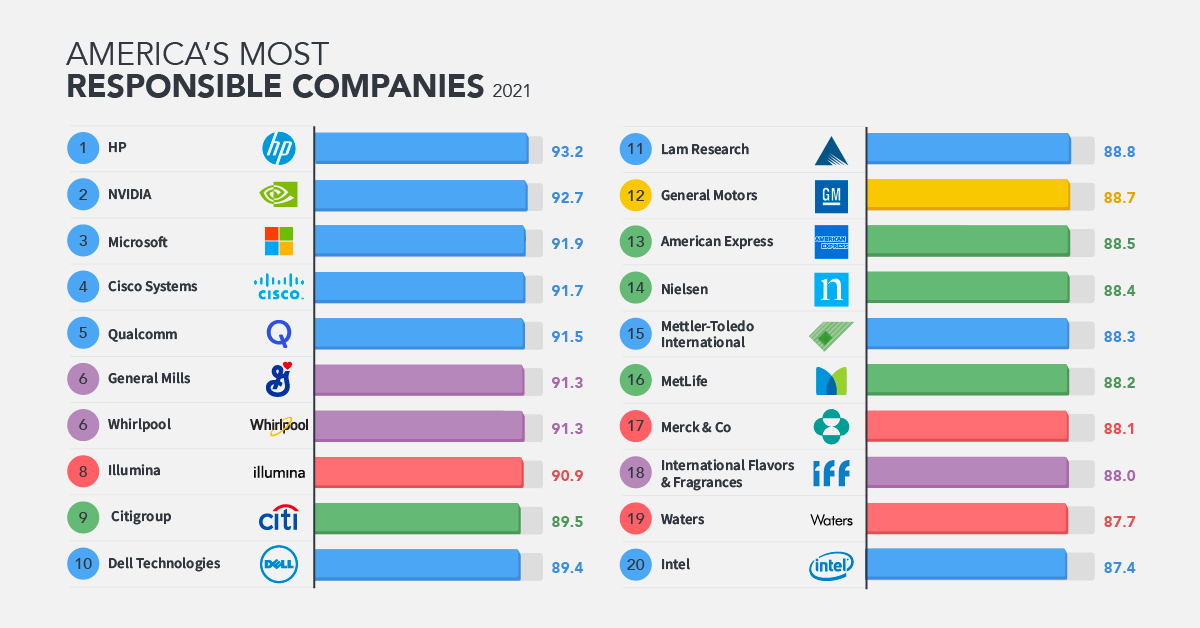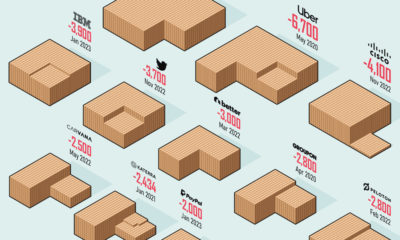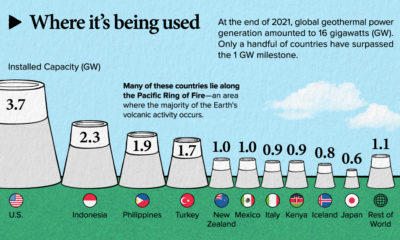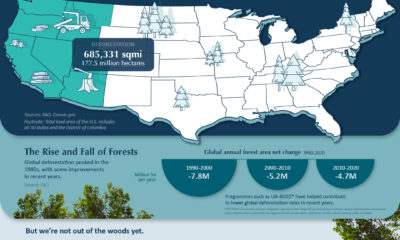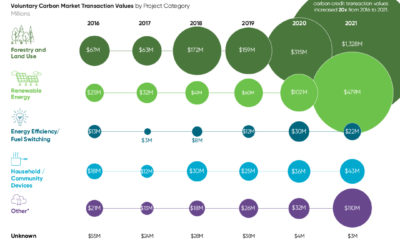Datastream
America’s Most Responsible Companies in 2021
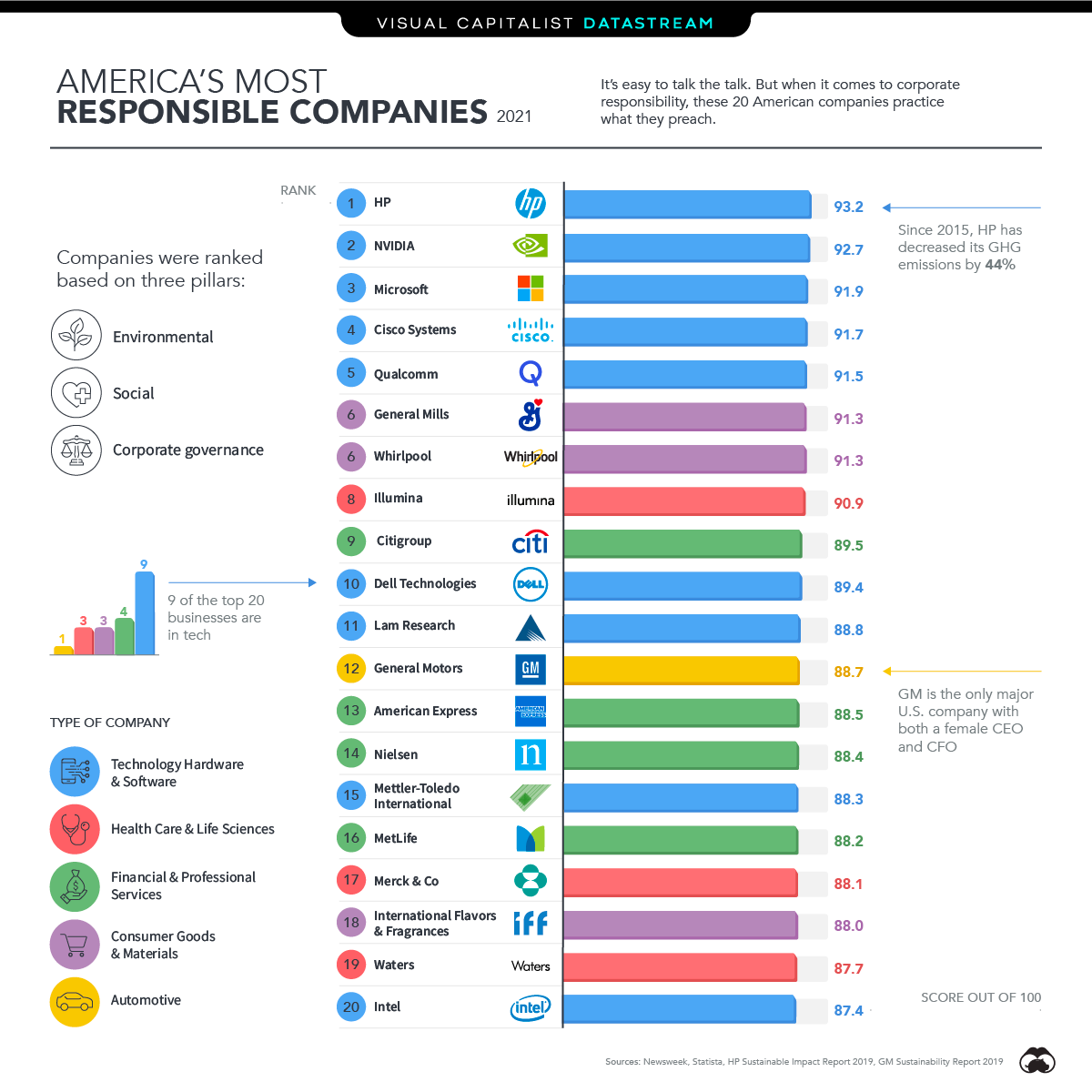
The Briefing
- Overall, HP was rated the most responsible American company in 2021
- When it came to environmental initiatives, Waters took the top spot. The biotech company has committed to reducing its emissions by 35% from its 2016 levels
- General Motors received the top score in social responsibility—it’s the only major U.S. company with both a female CEO and CFO
- In the corporate governance category, Qualcomm placed first. The company runs a number of education programs to help engage women and minorities in STEM related-fields
America’s Most Responsible Companies in 2021
Consumers are becoming increasingly more thoughtful about the brands they support and buy from. In the U.S. and UK, 68% of online consumers would or might stop buying from a brand with weak corporate responsibility practices.
Because of this, companies need to ensure their corporate social responsibility (CSR) initiatives are up to snuff in order to be competitive.
With this in mind, here’s a look at the top 20 most responsible companies in America, and what they’ve been doing to give back to their communities.
The Top 20 Most Responsible Companies
Newsweek and Statista used a four-step methodology to identify America’s most responsible companies. The process included a pre-screening, as well as in-depth CSR document review, and a consumer survey.
From there, companies were given a score out of 100 and ranked accordingly. With a score of 93.2, HP placed first as America’s most responsible company:
| Rank | Company | Overall Score (out of 100) |
|---|---|---|
| 1 | HP | 93.2 |
| 2 | NVIDIA | 92.7 |
| 3 | Microsoft | 91.9 |
| 4 | Cisco Systems | 91.7 |
| 5 | Qualcomm | 91.5 |
| 6 | General Mills | 91.3 |
| 7 | Whirlpool | 91.3 |
| 8 | Illumina | 90.9 |
| 9 | Citigroup | 89.5 |
| 10 | Dell Technologies | 89.4 |
| 11 | Lam Research | 88.8 |
| 12 | General Motors | 88.7 |
| 13 | American Express | 88.5 |
| 14 | Nielsen | 88.4 |
| 15 | Mettler-Toledo International | 88.3 |
| 16 | MetLife | 88.2 |
| 17 | Merck & Co | 88.1 |
| 18 | International Flavors & Fragrances | 88.0 |
| 19 | Waters | 87.7 |
| 20 | Intel | 87.4 |
In its 2019 Sustainable Impact Report, HP outlined how it’s been working to drive sustainability in three key areas—the planet, people, and community. And the company has made some impressive progress. For instance, in 2019 it used over 1 million pounds of ocean-bound plastic in its products.
It’s not a huge surprise that HP has taken the top spot on the list. The company is known for its innovation and progressive practices. In 2020, it was recognized as one of the top 20 most innovative organizations of the year.
Corporate Responsibility in a COVID World
The world’s continual struggle with COVID-19 has put an even larger emphasis on CSR, and the importance of supporting the community at large.
It’s no longer just the right thing to do. As consumer demand for transparency and corporate responsibility escalates, CSR practices are transitioning from a nice-to-have to a need-to-have. And organizations need to get on board before they’re left behind.
Where does this data come from?
Source: Newsweek and Statista
Notes: For more information on methodology, click here
Datastream
Can You Calculate Your Daily Carbon Footprint?
Discover how the average person’s carbon footprint impacts the environment and learn how carbon credits can offset your carbon footprint.

The Briefing
- A person’s carbon footprint is substantial, with activities such as food consumption creating as much as 4,500 g of CO₂ emissions daily.
- By purchasing carbon credits from Carbon Streaming Corporation, you can offset your own emissions and fund positive climate action.
Your Everyday Carbon Footprint
While many large businesses and countries have committed to net-zero goals, it is essential to acknowledge that your everyday activities also contribute to global emissions.
In this graphic, sponsored by Carbon Streaming Corporation, we will explore how the choices we make and the products we use have a profound impact on our carbon footprint.
Carbon Emissions by Activity
Here are some of the daily activities and products of the average person and their carbon footprint, according to Clever Carbon.
| Household Activities & Products | CO2 Emissions (g) |
|---|---|
| 💡 Standard Light Bulb (100 watts, four hours) | 172 g |
| 📱 Mobile Phone Use (195 minutes per day)* | 189 g |
| 👕 Washing Machine (0.63 kWh) | 275 g |
| 🔥 Electric Oven (1.56 kWh) | 675 g |
| ♨️ Tumble Dryer (2.5 kWh) | 1,000 g |
| 🧻 Toilet Roll (2 ply) | 1,300 g |
| 🚿 Hot Shower (10 mins) | 2,000 g |
| 🚙 Daily Commute (one hour, by car) | 3,360 g |
| 🍽️ Average Daily Food Consumption (three meals of 600 calories) | 4,500 g |
| *Phone use based on yearly use of 69kg per the source, Reboxed | |
Your choice of transportation plays a crucial role in determining your carbon footprint. For instance, a 15 km daily commute to work on public transport generates an average of 1,464 g of CO₂ emissions. Compared to 3,360 g—twice the volume for a journey the same length by car.
By opting for more sustainable modes of transport, such as cycling, walking, or public transportation, you can significantly reduce your carbon footprint.
Addressing Your Carbon Footprint
One way to compensate for your emissions is by purchasing high-quality carbon credits.
Carbon credits are used to help fund projects that avoid, reduce or remove CO₂ emissions. This includes nature-based solutions such as reforestation and improved forest management, or technology-based solutions such as the production of biochar and carbon capture and storage (CCS).
While carbon credits offer a potential solution for individuals to help reduce global emissions, public awareness remains a significant challenge. A BCG-Patch survey revealed that only 34% of U.S. consumers are familiar with carbon credits, and only 3% have purchased them in the past.
About Carbon Streaming
By financing the creation or expansion of carbon projects, Carbon Streaming Corporation secures the rights to future carbon credits generated by these sustainable projects. You can then purchase these carbon credits to help fund climate solutions around the world and compensate for your own emissions.
Ready to get involved?
>> Learn more about purchasing carbon credits at Carbon Streaming
-

 Markets1 week ago
Markets1 week agoU.S. Debt Interest Payments Reach $1 Trillion
-

 Business2 weeks ago
Business2 weeks agoCharted: Big Four Market Share by S&P 500 Audits
-

 Real Estate2 weeks ago
Real Estate2 weeks agoRanked: The Most Valuable Housing Markets in America
-

 Money2 weeks ago
Money2 weeks agoWhich States Have the Highest Minimum Wage in America?
-

 AI2 weeks ago
AI2 weeks agoRanked: Semiconductor Companies by Industry Revenue Share
-

 Markets2 weeks ago
Markets2 weeks agoRanked: The World’s Top Flight Routes, by Revenue
-

 Demographics2 weeks ago
Demographics2 weeks agoPopulation Projections: The World’s 6 Largest Countries in 2075
-

 Markets2 weeks ago
Markets2 weeks agoThe Top 10 States by Real GDP Growth in 2023

